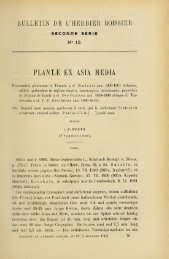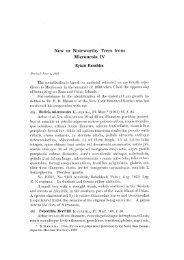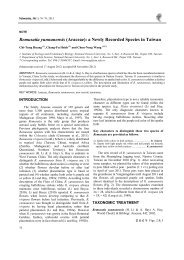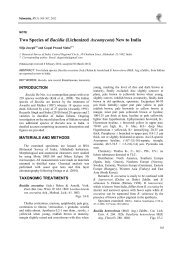A New Record of Bryum coronatum Schwaegr. (Bryophyte) in ...
A New Record of Bryum coronatum Schwaegr. (Bryophyte) in ...
A New Record of Bryum coronatum Schwaegr. (Bryophyte) in ...
Create successful ePaper yourself
Turn your PDF publications into a flip-book with our unique Google optimized e-Paper software.
September, 2012 Bansal and Nath: A new record <strong>of</strong> <strong>Bryum</strong> <strong>coronatum</strong> from India<br />
Fig. 1. Map show<strong>in</strong>g distribution <strong>of</strong> <strong>Bryum</strong> <strong>coronatum</strong> <strong>in</strong> Tura, West Garo hills<br />
India and adjacent regions and reported 248 species <strong>of</strong><br />
mosses belong<strong>in</strong>g to 120 genera from different parts <strong>of</strong><br />
Meghalaya, ma<strong>in</strong>ly from Khasia hills. He reported<br />
<strong>Bryum</strong> argenteum, <strong>Bryum</strong> medianum, <strong>Bryum</strong><br />
caespiticium, <strong>Bryum</strong> alp<strong>in</strong>um, <strong>Bryum</strong> porphyroneuron<br />
and <strong>Bryum</strong> paradoxum from Khasia hills, but there is no<br />
record <strong>of</strong> B. <strong>coronatum</strong> from Meghalaya (west Garo<br />
hills) previously. Recently dur<strong>in</strong>g monographic studies<br />
on Indian taxa <strong>of</strong> the genus <strong>Bryum</strong> Hedw., some plants<br />
collected from Teele Tura hills <strong>of</strong> west Garo become a<br />
new record species for Meghalaya.<br />
MATERIALS AND METHODS<br />
The study is based on the specimens available at the<br />
<strong>Bryophyte</strong> Herbarium <strong>of</strong> the National Botanical<br />
Research Institute, Lucknow (India) and were earlier<br />
collected from the forest <strong>of</strong> Teele Tura hills, west Garo,<br />
at an average height <strong>of</strong> 410 m above sea level dur<strong>in</strong>g<br />
September, 1999.<br />
TAXONOMIC TREATMENT<br />
<strong>Bryum</strong> <strong>coronatum</strong> <strong>Schwaegr</strong>. Sp. Musc. Frond., Suppl.<br />
1(2): 103. pl. 71. 1816. Fig. 2<br />
Plants very small, closely tufted, bright-dull green to<br />
yellowish-green above, dark brown below and <strong>in</strong> lower<br />
part matted with brown radicles, tomentose at base,<br />
rarely up to ±2 cm high. Stems slender, short, more or<br />
less erect, green, becom<strong>in</strong>g reddish or brownish <strong>in</strong> lower<br />
portions, branched from base. Leaves numerous, more<br />
crowded and closer <strong>in</strong> the upper portion <strong>of</strong> stem, more<br />
distant below, erect to erectopatent, not greatly<br />
contorted when dry, slightly decurrent, 1.8-2.8 × 1.2-1.4<br />
mm, imbricate, ovate to oblong-lanceolate, sharply<br />
acum<strong>in</strong>ate; marg<strong>in</strong>s entire, flat; costa strong, red to<br />
reddish-brown, long excurrent <strong>in</strong> a ±0.5 mm long<br />
slightly denticulate arista; apical lam<strong>in</strong>al cells th<strong>in</strong> to<br />
thick walled, narrowly hexagonal-rhomboidal, ±55-65 ×<br />
7-12 µm, narrower towards marg<strong>in</strong> but without any<br />
clearly def<strong>in</strong>ed border, median lam<strong>in</strong>al cells narrowly<br />
295








